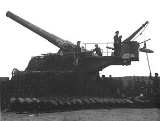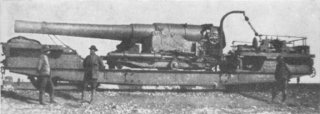
BL 9.2 inch Railway Gun
Encyclopedia
The Ordnance BL 9.2 inch gun on truck, railway mounted a variety of surplus 9.2 inch naval guns, together with the custom-designed Mk XIII railway gun, on various railway platforms to provide mobile long-range heavy artillery on the Western Front in World War I
.
 A 9.2 inch railway gun was in fact first deployed in 1900. The British mounted a 9.2 inch gun from the Cape Town coastal defences on a railway truck and sent it up the railway line to support the British assault on Boer defences at Belfast
A 9.2 inch railway gun was in fact first deployed in 1900. The British mounted a 9.2 inch gun from the Cape Town coastal defences on a railway truck and sent it up the railway line to support the British assault on Boer defences at Belfast
, north-east of Johannesburg. The battle ended on 27 August 1900 before the gun arrived, and as the Boers thereafter resorted to guerrilla warfare this innovation was not used in action during the war.
naval and coast-defence guns were adapted by the Elswick Ordnance Company for mounting on railway trucks for use in France and Belgium. They were mounted on Vavasseur slides, which travelled backwards and upwards to absorb the recoil, on "well-based" trucks, where the base was level with the axles.
These early mountings allowed 10° of traverse left and right, and moved forward and backwards alonged curved sections of track for further traversing. They limited elevation to 28° and hence limited maximum range. In March 1916 a modification increased elevation to 35°.
 In June 1916 Elswick produced a more sophisticated turntable mounting with a loading platform, on a "straight-back" truck which mounted the gun much higher. This was lowered to the ground for firing, had outriggers for stability, allowed 360° traverse and elevation to 30°. The more modern Mk X gun
In June 1916 Elswick produced a more sophisticated turntable mounting with a loading platform, on a "straight-back" truck which mounted the gun much higher. This was lowered to the ground for firing, had outriggers for stability, allowed 360° traverse and elevation to 30°. The more modern Mk X gun
was mounted on this design, together with 2 Mk X variants intended for Australian coast defence (Mk XT), 4 Vickers 45-calibre guns (Mk XIV) which were originally intended for a foreign order, and a specially developed 35-calibres railway gun (Mk XIII).
.
 9.2-inch railway guns expended 45,000 rounds during World War I
9.2-inch railway guns expended 45,000 rounds during World War I
. At the Armistice guns in service were :
First Army : 6 guns : Batteries 366 (2), 461 (2), 523 (2)
Second Army : 3 guns : Batteries 45 (2), 53 (1)
Third Army : 4 guns : Batteries 363 (2), 442 (2)
Fifth Army : 3 guns : Batteries 53 (1), 546 (2)
Mk XIII guns remained in service until 1945; all others were declared obsolete after World War I
.
World War I
World War I , which was predominantly called the World War or the Great War from its occurrence until 1939, and the First World War or World War I thereafter, was a major war centred in Europe that began on 28 July 1914 and lasted until 11 November 1918...
.
Second Boer War 1899-1902

Battle of Bergendal
The Battle of Bergendal was the last set-piece battle of the Second Anglo-Boer War. It lasted from 21–27 August 1900 and took place on the farm Bergendal near the town of Belfast...
, north-east of Johannesburg. The battle ended on 27 August 1900 before the gun arrived, and as the Boers thereafter resorted to guerrilla warfare this innovation was not used in action during the war.
World War I
Early in 1915 a variety of surplus Mk III and Mk VI 9.2-inchBL 9.2 inch gun Mk I - VII
The BL 9.2 inch guns Mk I - Mk VII were a family of early British heavy breechloading naval and coast defence guns in service from 1881 to the end of World War I...
naval and coast-defence guns were adapted by the Elswick Ordnance Company for mounting on railway trucks for use in France and Belgium. They were mounted on Vavasseur slides, which travelled backwards and upwards to absorb the recoil, on "well-based" trucks, where the base was level with the axles.
These early mountings allowed 10° of traverse left and right, and moved forward and backwards alonged curved sections of track for further traversing. They limited elevation to 28° and hence limited maximum range. In March 1916 a modification increased elevation to 35°.

BL 9.2 inch gun Mk IX - X
The BL 9.2 inch guns Mk IX and Mk X were British 46.7 calibres naval and coast defence guns in service from 1899 to the 1950s. They had possibly the longest, most varied and successful service history of any British heavy ordnance.-History:...
was mounted on this design, together with 2 Mk X variants intended for Australian coast defence (Mk XT), 4 Vickers 45-calibre guns (Mk XIV) which were originally intended for a foreign order, and a specially developed 35-calibres railway gun (Mk XIII).
Mk XIII gun
The custom-designed 35-calibres Mk XIII gun had a heavier breech which allowed the trunnions to be closer to the breech and hence the breech did not depress as far when the barrel was elevated. On a new Mk IV mounting, Mk XIII guns could then be elevated to 40° and attain a range of 22,600 yards. These remained in service until 1945, serving in the home defence of Britain in World War IIWorld War II
World War II, or the Second World War , was a global conflict lasting from 1939 to 1945, involving most of the world's nations—including all of the great powers—eventually forming two opposing military alliances: the Allies and the Axis...
.
Combat service

World War I
World War I , which was predominantly called the World War or the Great War from its occurrence until 1939, and the First World War or World War I thereafter, was a major war centred in Europe that began on 28 July 1914 and lasted until 11 November 1918...
. At the Armistice guns in service were :
First Army : 6 guns : Batteries 366 (2), 461 (2), 523 (2)
Second Army : 3 guns : Batteries 45 (2), 53 (1)
Third Army : 4 guns : Batteries 363 (2), 442 (2)
Fifth Army : 3 guns : Batteries 53 (1), 546 (2)
Mk XIII guns remained in service until 1945; all others were declared obsolete after World War I
World War I
World War I , which was predominantly called the World War or the Great War from its occurrence until 1939, and the First World War or World War I thereafter, was a major war centred in Europe that began on 28 July 1914 and lasted until 11 November 1918...
.
Further reading
- Harry W Miller, United States Army Ordnance Department, Railway Artillery: A Report on the Characteristics, Scope of Utility, Etc., of Railway Artillery, Volume II, Pages 126-136. Washington : Government Print Office, 1921
External links
- Per Finsted, Om engelsk jernbaneartilleri under Første Verdenskrig (in Danish)

